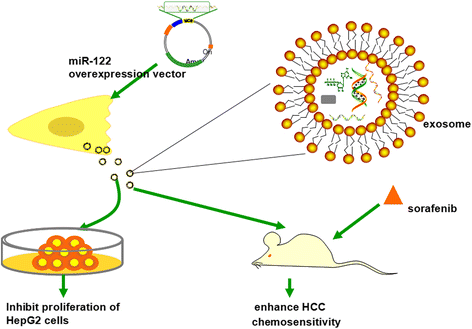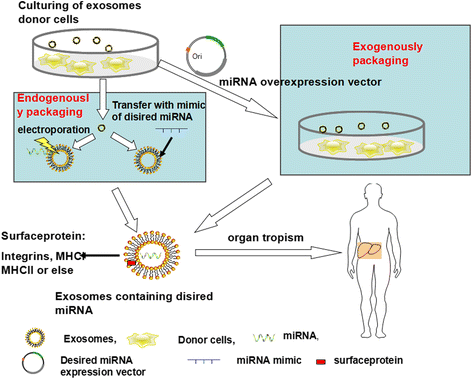Exosomal miRNAs in hepatocellular carcinoma development and clinical responses
- PMID: 29642941
- PMCID: PMC5896112
- DOI: 10.1186/s13045-018-0579-3
Exosomal miRNAs in hepatocellular carcinoma development and clinical responses
Abstract
Hepatocellular carcinoma remains the sixth most lethal malignancy in the world. While HCC is often diagnosed via current biomarkers at a late stage, early detection of HCC has proven to be very difficult. Recent studies have focused on using exosomal miRNAs in clinical diagnostics and therapeutics, because they have improved stability in exosomes than as free miRNAs themselves. Exosomal miRNAs act through novel mechanisms for inducing cellular responses in a variety of biological circumstances. Dysregulated expression of miRNAs in exosomes can also accelerate HCC progression, including cell proliferation and metastasis, via alteration of a network of genes. Growing evidence demonstrates that exosomal miRNAs can affect many aspects of physiological and pathological conditions in HCC and indicates that miRNAs in exosomes can not only serve as sensitive biomarkers for cancer diagnostics and recurrence but can also potentially be used as therapeutics to target HCC progression. In this review, we summarize the latest findings between exosomal miRNAs and HCC, in order to better comprehend the functions and applications in HCC. Moreover, we discuss critical issues to consider when developing anti-tumor exosomal miRNAs as a novel therapeutic strategy for treating HCC in the clinic.
Keywords: Diagnosis; Exosome; Hepatocellular carcinoma; miRNAs.
Conflict of interest statement
Ethics approval and consent to participate
Not applicable.
Consent for publication
Not applicable.
Competing interests
The authors declare that they have no competing interests.
Publisher’s Note
Springer Nature remains neutral with regard to jurisdictional claims in published maps and institutional affiliations.
Figures


Similar articles
-
Acidic Microenvironment Up-Regulates Exosomal miR-21 and miR-10b in Early-Stage Hepatocellular Carcinoma to Promote Cancer Cell Proliferation and Metastasis.Theranostics. 2019 Mar 16;9(7):1965-1979. doi: 10.7150/thno.30958. eCollection 2019. Theranostics. 2019. PMID: 31037150 Free PMC article.
-
Exosomal MiR-744 Inhibits Proliferation and Sorafenib Chemoresistance in Hepatocellular Carcinoma by Targeting PAX2.Med Sci Monit. 2019 Sep 25;25:7209-7217. doi: 10.12659/MSM.919219. Med Sci Monit. 2019. PMID: 31553714 Free PMC article.
-
[Hepatocellular carcinoma-derived exosomal miRNA expression and its clinical value].Zhonghua Gan Zang Bing Za Zhi. 2020 Jan 20;28(1):83-86. doi: 10.3760/cma.j.issn.1007-3418.2020.01.020. Zhonghua Gan Zang Bing Za Zhi. 2020. PMID: 32023707 Review. Chinese.
-
Exosomal microRNAs in hepatocellular carcinoma, expanding research field.World J Gastroenterol. 2024 May 28;30(20):2618-2620. doi: 10.3748/wjg.v30.i20.2618. World J Gastroenterol. 2024. PMID: 38855155 Free PMC article.
-
Role of exosomes and exosomal microRNAs in hepatocellular carcinoma: Potential in diagnosis and antitumour treatments (Review).Int J Mol Med. 2018 Apr;41(4):1809-1816. doi: 10.3892/ijmm.2018.3383. Epub 2018 Jan 11. Int J Mol Med. 2018. PMID: 29328436 Free PMC article. Review.
Cited by
-
Depletion of exosomal circLDLR in follicle fluid derepresses miR-1294 function and inhibits estradiol production via CYP19A1 in polycystic ovary syndrome.Aging (Albany NY). 2020 Jul 10;12(15):15414-15435. doi: 10.18632/aging.103602. Epub 2020 Jul 10. Aging (Albany NY). 2020. PMID: 32651991 Free PMC article.
-
Anti-Hepatocellular Carcinoma Biomolecules: Molecular Targets Insights.Int J Mol Sci. 2021 Oct 6;22(19):10774. doi: 10.3390/ijms221910774. Int J Mol Sci. 2021. PMID: 34639131 Free PMC article. Review.
-
Exosome-mediated miRNA delivery promotes liver cancer EMT and metastasis.Am J Transl Res. 2020 Mar 15;12(3):1080-1095. eCollection 2020. Am J Transl Res. 2020. PMID: 32269736 Free PMC article.
-
Exosome encapsulated ncRNAs in the development of HCC: potential circulatory biomarkers and clinical therapeutic targets.Am J Cancer Res. 2021 Aug 15;11(8):3794-3812. eCollection 2021. Am J Cancer Res. 2021. PMID: 34522450 Free PMC article. Review.
-
Value of AFP and PIVKA-II in diagnosis of HBV-related hepatocellular carcinoma and prediction of vascular invasion and tumor differentiation.Infect Agent Cancer. 2020 Nov 23;15(1):70. doi: 10.1186/s13027-020-00337-0. Infect Agent Cancer. 2020. PMID: 33292429 Free PMC article.
References
Publication types
MeSH terms
Substances
LinkOut - more resources
Full Text Sources
Other Literature Sources
Medical

